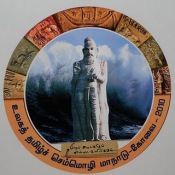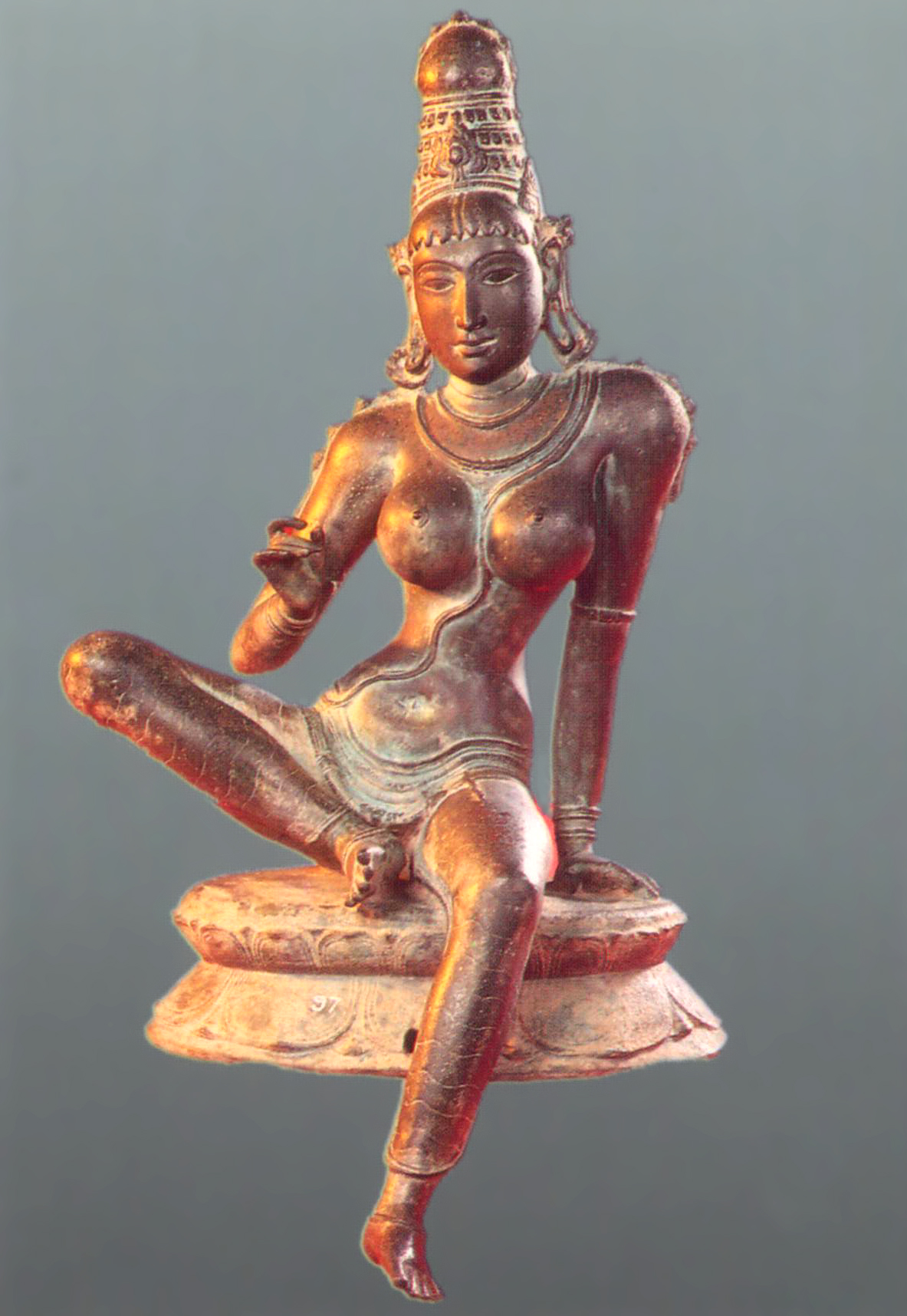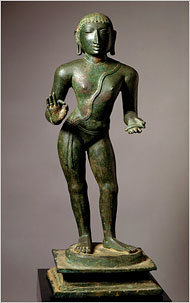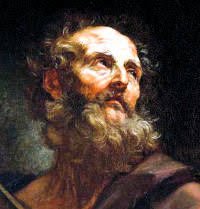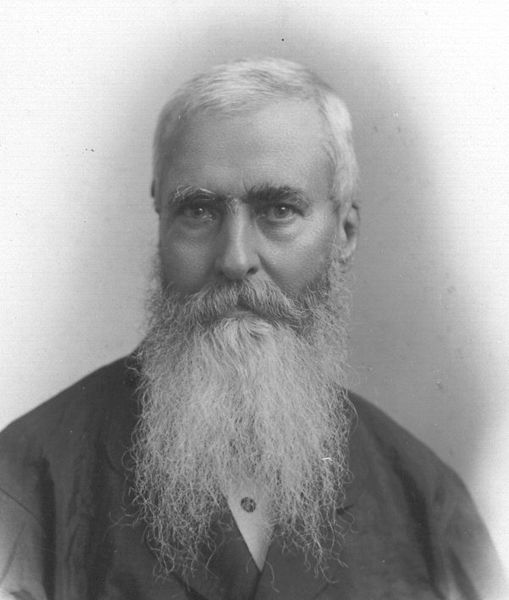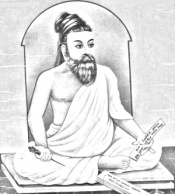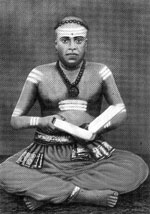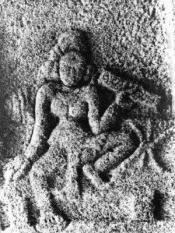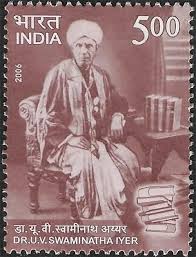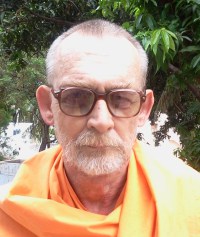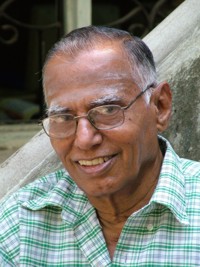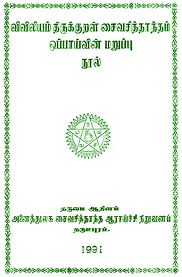- Joined
- Nov 10, 2020
- Messages
- 12,207
- Likes
- 73,694
Demolished : The Myth Of st. thomas.
Author : TRUE INDOLOGY and NS RAJARAM
According to Christian leaders in India, the Apostle Thomas came to BHARAT in 52 ad., founded the Syrian Christian Church, and was killed by the fanatical Brahmins in 72 ad. His followers built the St. Thomas Church near the site of his martyrdom. Historians however say this apostle, even if he existed, never came to India. The Christian community in South India was founded by a Syrian (or Armenian) merchant Thomas Cananeus in 345 ad. He led four hundred refugees who fled persecution in Persia and were given asylum by the Hindu authorities.
This story was too commonplace to attract converts. So Christian leaders identified the merchant Thomas with Apostle Thomas and created the dramatic story of the Apostle’s persecution and death at the hands of the “wicked”Brahmins of South India. This became current in the 16th century when thePortuguese gained control of the west coast of India and forced the Syrian Christians to follow the Catholic faith. The Portuguese also destroyed theKapaleeswara Temple that originally stood on the site now occupied by the San Thome Cathedral on the beach.
The creation of this myth and the history is told in detail by the well renowed scholar Ishwar Sharan in his famous book The Myth of St. Thomas and the Mylapore Shiva Temple. The purpose of the myth was to create a local martyr. Christianity depends heavily on the appeal of martyrs who are projected as victims like Jesus Christ. Then as now, Church leaders liked to pose as victims to generate sympathy and propaganda. But no matter how much they tried, the Hindus of India refused to supply the Portuguese with martyrs. So they were forced to create their own. So they turned the merchant Thomas into the Apostle Thomas killed by the Hindus.
In his foreword to Ishwar Sharan’s book, the Belgian scholar Koenraad Elst wrote:
“In Catholic universities in Europe, the myth of the apostle Thomas going to India is no longer taught as history, but in India it is still considered useful. Even many vocal ‘secularists’ who attack the Hindus for relying on myth in the Ayodhya affair, off-hand profess their belief in the Thomas myth. The important point is that Thomas can be upheld as a martyr and the Brahmins decried as fanatics.”
The legend of Thomas’ Martyrdom in the hands of Brahmins has its origin an ignorant and intentional misreading of an inscription.
Targeting Brahmins to undermine Hinduism was a favorite tactic among missionaries. Elst gives the true picture: “In reality, the missionaries were very disgruntled that the damned Hindus refused to give them martyrs (whose blood is welcomed as ‘the seed of the faith’), so they had to invent one. Moreover, the church which they claim commemorates St. Thomas’ martyrdom at the hands of Hindu fanaticism, is in fact a monument of Hindu martyrdom at the hands of Christian fanaticism. It is a forcible replacement of two important Hindu temples (Jain and Shaiva) whose existence was insupportable to the Christian missionaries.”
Another motivation for the myth was to erase the unsavory record of the Catholic Church’s close association with the Portuguese pirates and even worse, the Goa Inquisition inspired by St. Xavier. But serious scholars including Christians have rejected this myth as we shall soon see.
Who was this Apostle Thomas and why was his name invoked? The main sources relating to Apostle Thomas are two Gnostic (non-Biblical) texts known as the Acts of Thomas and the Gospel of Thomas. According to them Thomas was the twin brother of Jesus. For this reason the Thomas myth is not accepted by the Vatican because of a doctrinal problem: Jesus as the Only Son of God cannot possibly have a twin brother. (Greek for Thomas is Didymus, which means twin brother.)
Christians in South India who identify themselves as St. Thomas Christians claim that their ancestors were blessed by Apostle Thomas in 52 ad. who preached from the Bible. This has no historical basis as we shall see. In fact, there is no evidence that Thomas even existed. His “history” is full of contradictions as will become apparent.
As just observed the Portuguese missionaries who came to India in the 16th century found that they could not do without a local martyr and created the myth of St. Thomas claiming that he was martyred in India. They gave no explanation as to how they discovered it more than 1500 years later. Marco Polo is supposed to have mentioned it but there is no authenticmanuscript that can be attributed to him. Then there is the question of how he discovered it more than a thousand years later.
There is even a tomb that is supposed to contain his martyred remains in Mylaporein Chennai. But the problem is there are several such memorials spread across Persia, Acre (Israel) and a few other places dating to different times, all laying claim to be the place where Apostle Thomas was martyred and buried!
After examining all the evidence, the late Father Heras, former Director of the Historical Research Institute, St. Xavier’s College, Bombay, said in 1953 that he was convinced that the tomb of St. Thomas was not in Mylapore. He had earlier said, quite emphatically in The Aravidu Dynasty of Vijayanagara, that the Portuguese account of their discovery of some relics was “a most barefaced imposture [with] all elements of a forgery.” Heras was himself a Jesuit father but also an eminent historian.
This is not the end of the story, for while denying the myth because it challenges Jesus as the “Only Son of God” the Vatican wants to have it both ways. On September 27, 2006, Pope Benedict XVI gave a speechat St. Peter’s in Rome in which he recalled an ancient tradition claiming that Thomas first evangelized Syria and Persia, then went on to Western India, from where Christianity also reached Southern India. Syrian Christians derive status within the caste system from the tradition that they are converted Namboothiris (Brahmins), who were allegedly evangelized by St. Thomas after his delusional landing in Kerala in ad 52.
There are serious problems with this theory: the Namboothiris started settling in Kerala only from the fourth century onwards, which means they did not exist at the time the alleged St. Thomas allegedly came to Kerala. So we have a possibly non-existent apostle preaching in the first century from a text, the New Testament, dating to the fourth century, to a people, the Namboothiris who settled in the fourth century or later. In reality the Pope’s original statement at St. Peter’s, reflected the geography of the Acts of Thomas, i.e. Syria, Parthia (Persia / Iran) and Gandhara (Afghanistan / Northwest Pakistan) — all far removed from Kerala in the southernmost tip of India.
This is not the end to the contradictions. If Thomas landed in Kerala in 52 AD, he could not have taught from the Christian Bible(New Testament) with its four gospels which came into existence only in the fourth century. In fact Christianity did not exist at the time because there was no Christian scripture! In addition, the famous St. Thomas Cross supposedly brought by him made its appearance in Kerala only in the fourth century, about the same time as the Namboothiri Brahmins. So it is quite possible that the highly ornate St. Thomas Cross [with Hindu motifs carved in it] was borrowed from the Namboothiris, having nothing to do with St. Thomas or even Christians. The Church borrowed its cross from the Egyptians and the oldest so-called St. Thomas Cross is a pagan Persian symbol.
As if this were not confusing enough, FatherFrancis Clooney, a theologian with the harvard School has stated that St Thomas had preached in Brazil, no matter that Brazil as we understand today was unknown in his time. According to Clooney, one Ruiz de Montoya, writing in Peru in the mid-seventeenth century, thought that since God would not have overlooked the Americas for fifteen hundred years, and since among the twelve apostles St. Thomas was known for his mission to the “most abject people in the world, blacks and Indians,” it was only reasonable to conclude that St. Thomas had preached throughout the Americas:
“He began in Brazil – either reaching it by natural means on Roman ships, which some maintain were in communication with America from the coast of Africa, or else, as may be thought closer to the truth, being transported there by God miraculously. He passed to Paraguay and from there to the Peruvians.
So here is the substance of the St. Thomas story. First, if he existed he was a twin brother of Jesus which is unacceptable because Jesus was the Only Son of God(born to a virgin). Next, he could not have preached Christianity in 52 AD because Christianity and the New Testament came into existence only in the fourth century, after the Council of Nicaea called by Roman Emperor Constantine in 325 AD. The first Christians came to India with the Syrian merchant Thomas in 345 AD escaping persecution in Persia. This was probably because Roman and Persian empires were great rivals. The Namboothiri Brahmins settled in Kerala only after the fourth AD, so could not have been converted by Apostle Thomas in 52 AD using the Bible from three centuries later.
Finally, the myth was created by Portuguese missionaries in the sixteenth century with the help of pirates. They destroyed also the Kapaleeswara Temple and a Jain temple building the church known as San Thome Cathedral in 1504. It acquired its present status and recognition as a cathedral (grand church) under British patronage in 1893. It was also the Portuguese who converted the Syrian Christians to the Catholic faith.
Hence there is absolutely no need to take this hoax of st. thomas seriously. Its all fabrication stories.
In an article recently published by Haaretz, it has been claimed that Saint Thomas was murdered by jealous Brahmin priests of Kali with the headline– 72 CE: Thomas the Apostle Is Murdered in India. The official website of Saint Thomas(Santhome) church states-
St Thomas, one of the twelve Apostles of our Lord and Saviour Jesus Christ, walked on the sands of Mylapore and preached the Gospel to the people who embraced Christianity. This great Apostle was martyred on St Thomas Mount, near Mylapore in the year 72 AD and his mortal remains were buried in Santhome in the Church built by him….
The claims are summarised as follows
The Portuguese Crusade.
As soon as they reached Calicut in 1498, the Portuguese announced that they were looking for spices and “Christians” . In Kerala, the Portuguese encountered Christians who were mostly known as “Syrians” and “Thomas Christians”. The search for “Christians” was obviously a justification and legitimization of future conquests. The Portuguese could simply portray their future conquests as a crusade to reconquer lost Christian lands. The Portuguese also claimed that conquest of non-Christian lands was an accomplishment that could closely precedent last Judgement. Portuguese historian Ameal sums up the Portuguese age of expansion as follows-
Wherever the Portuguese fleet cast anchor in the past, barbarity disappeared while the idols of tyranny, hatred, and gold were replaced by the cross of Christ. No colonization was more beautiful and noble….
Thus, it is clear that Portuguese conquest/expansion and Christianization went hand in hand.
India and christianity.
The tales of “Thomas in India” were well known throughout Europe in the medieval age. Hagiographical Latin works on Saint Thomas such as Flos sanctorum, De miraculis beati Thomae apostoli and Passio Sancti Thomae were well known in literary circles. These Latin works were not a faithful translation of the original Christian apocryphal scripture, Acts of Thomas, but further reworkings of it.
Given this background, it is no surprise that as early as 1507, the Portuguese Viceroy Almeida sent out a preliminary expedition to south to look for the tomb of St Thomas the Apostle . As observed, any discovery of St. Thomas would legitimise their conquests. However, the first mission was a total failure and Portuguese failed to find what they were looking for.
Thomas Legends procured from native “Thomas” Christians.
As a part of this grand project, Portuguese writer Duarte Barbosa completed his work “Geographical compendium of Portuguese Asia”(c.1518). He provided his account of the life and death of St. Thomas in India by reproducing the oral stories of the St. Thomas Christians from the region of Kollam(Kerala).
This account of St. Thomas in India, based on the oral stories, was full of myths. Relevant to us, however, is a striking reference on the “martyrdom” of saint Thomas. The miracle worker Thomas transformed himself into a peacock and wandered around. A low caste govi hunter shot at it. The hunter was shocked when the peacock retransformed itself into its original form of Saint Thomas.
Thus,in the earliest legends of Thomas Christians, St. Thomas was killed not by jealous Brahmins but by a low caste hunter who mistook him for a peacock. The legend of transformation of Thomas into peacock prior to his accidental death at the hands of a hunter was also noted centuries earlier by Marco Polo(1296) who collected his legends from the accounts of local Christians.
We pause and ask, why did Barbosa rely on the local accounts of St. Thomas Christians to reconstruct the history and martyrdom of St. Thomas? The Acts of Thomas which talked about martyrdom of Thomas in “India” was an old Apocryphal Biblical text. As noted, the Europeans had their own medieval accounts of Thomas’ martyrdom.
The Portuguese considered St. Thomas Christians as “heretics” and “Nestorians” and would soon force the Catholic religion upon them. Why did the Portuguese adopt late mythical foreign accounts of Hinduised “heretics” and discard their own versions of Thomas legend?
The answer lies in the fact that the Apocryphal text Acts of Thomas(written 3rd century) was never received very well in Christendom. As early as 310 AD, foremost early Christian historian and bishop Eusebius classified apocryphal acts as “heretical works” written by the “wicked and impious”.
Epiphanus of Salamis( 370AD) testified that Acts of Thomas were used by the “heretic Encratites”. After protestant reformations, the Catholics began a counter reformation movement and embraced stricter orthodoxy. The Acts would soon be condemned in the Catholic Council of Trent(1548 AD). Although not translations, the medieval works on saints were still based on Acts. Hence, even these works were considered “unorthodox”.
There is also another reason for discarding the western legends. According to the Acts of Thomas, the body of St. Thomas was taken to the West after his death.Ephraim the Syrian(d.377) mentioned that the body of Thomas was venerated in Edessa(Syria) .
Gregory of Tours (583-594) evoked the Syrian tradition in shifting St.Thomas’s burial from India to Edessa. By 1258,it was taken to Ortona, Italy where the skeleton of St. Thomas is venerated to this day. The Vatican also acknowledged these relics of “Thomas” with “deed of verification” meaning that the Christendom considers it to be the ‘real skeleton’ of St. Thomas.
Even in the widely read Travels of Sir John Mandeville(c.1499), it was stated that Thomas’ body was taken to Edessa(Syria, now Turkey) from India after his death. Had Portuguese adopted the old western legends of Thomas, they could not have claimed any Thomas grave in India. But as we have noted before, this was crucial for legitimization of their conquests.
Geographical expansion of the site.
In 1517, Armenian merchants came to the rescue of the Portuguese. They talked about a sepulchre of St. Thomas and persuaded a group of Portuguese returning from Melakka to travel to a site in Mylapore reputed to be St. Thomas’ tomb. When they arrived, what they found were partially ruined temples. Below we quote description of what the Portuguese saw when they arrived at supposed tomb of St. Thomas in Mylapore-
They found a vast expanse covered with buildings, for most part in ruins. Amongst these ancient remains were gopuras, towers, columns, stones covered with sculptures representing foliage, human figures, animals, birds of such exquisite workmanship that they could not have been finer even wrought in silver …
They found that the tomb was visited by heathens(Hindus) and Moors(Muslims), in addition to local Christians. Even Marco Polo had written centuries earlier that the tomb used to be visited by “Saracens(Muslims) and Christians.”
The tomb itself was managed by a Muslim who claimed it to be a tomb of a Muslim saint from Ethiopia. However, the presence of temples at the place of St. Thomas’ martyrdom should not have come as a surprise to Portuguese. Consider a more than century older testimony of Christian monk Odoric of Udine who recalled a visit he had made to this Tomb in 1322.
His church is filled with idols and beside it are fifteen houses of the Nestorians, that is to say Christians, but vile and pestilential heretics…
These Jesuit historians claim that this had been a temple of a Jogi which was appropriated by Thomas himself. But they are only partially correct. It was indeed a temple of a Jogi, but it is the Portuguese, not Thomas, who have appropriated it.They also found footprints which they considered to be those of St. Thomas. However, veneration of footprints is a Hindu-Jain-Buddhist practice.
We have further testimony from Manual Gomes, a Portuguese who took part in the expedition. They saw another tomb, which, they were sure, was that of St. Matthew the apostle and alleged author of canonical gospel.
The Portuguese then began reconstruction of this site, now called “St. Thomas chapel”. The tombs were opened one after the other and their bones exhumed. The Tamil inscription of what had until now been considered “St. Matthew’s Tomb” read as “tane mudaliar” and was found to be that of a Chola ruler. The Portuguese took a massive U turn.
Now, St. Matthew’s tomb became that of Chola ruler who had been a “disciple” of St. Thomas. It did not matter to them that the Chola ruler and St Thomas were separated by a time frame of 12 centuries. The tomb of “St. Thomas” was also exhumed. Among the finds was a wooden shaft of St. Thomas which miraculously survived for 15 centuries.
The Portuguese began their project and built churches all over the place. Retired Portuguese traders and Jesuit priests began to settle in Mylapore. A large number of locals were converted and a Christian colony in Mylapore was now a fact.
Brahminic(Jesuit?) reconstruction of Thomas’ Myth.
The tomb of St. Thomas was located on Little Mount(chinna malai) of Mylapore. The Portuguese also constructed a chapel on Big Mount(Periya Malai) to the south east of tomb. One day, during an excavation on the Big Mount, the Portuguese claimed to have come across an exciting find. They suddenly found a cross with small “drops of blood” on its surface. They also found an inscription on it. They invited a learned Brahmin named Pingali Suranna to decipher the inscription. Suranna translated it much to the delight of Portuguese which read as follows-
During the time of the Sagamo laws, Thomas the divine man was sent by the Son of God (whose disciple he was) to these countries to lead the people of this nation to the knowledge of God, and he erected a temple and performed miracles and finally, while he was praying on his knees before this cross, he was pierced by a Brahman’s spear and this cross was tinged with his blood for eternal memory…..
It should be mentioned that this version of Thomas’ Martyrdom corresponds to the version Jesuit priests knew from their books such as Acts of Thomas. There is however an important difference. In the Acts of Thomas, Thomas was killed by the king because he converted the queen and instructed her not to have any sexual intercourse with the king. It seems Jesuits wanted to implicate Brahmins and localise the myth. It is interesting that Suranna words come across as though from a Jesuit’s mouth.
Now, the Thomas legend underwent major reconstructions. It wasn’t a peacock hunter who accidentally killed Thomas but a Brahmin who intentionally committed the deed. The Little mount(cinna malai) was no longer the resting place of Thomas. Thomas was pierced by a spear on the Little mount after which he fled to the Big Mount, finally dying there, clasping the cross. The Big Mount was now the final resting place of Thomas, as it is until today.
One wonders how the Brahmin Suranna was able to read the indecipherable inscription. Brahmins were trained in Vedas and traditional sciences such as mathematics(Ganita), astrology and Ayurveda, but not linguistic epigraphy. The Brahmins with all their knowledge had no idea what Brahmi script was.
Thanks to James Princep the epigraphist who deciphered Brahmi in 1837, we are in a much better position to understand Indian history. Now we now know what was inscribed on the cross, thanks to modern day Epigraphists. The inscription is in Pahlavi. It is dated to circa. 8th century CE. It read-
My Lord Christ, have pity on Afras, son of Chaharbukt the Syrian, who has carved this….
As we see, there is no mention of any St. Thomas, let alone his Martydom. Thus, the legend of Thomas’ Martyrdom in the hands of Brahmins has its origin an ignorant and intentional misreading of an inscription.
It is most likely, that the inscription was brought from Goa and deliberately planted it on the mount.Recently,a similar inscription was found at Goa.
Indologist Dr. Koenraad Elst has written a comprehensive foreword for the book. His short foreword to the 1995 edition is posted below as he makes some pertinent remarks about Indian secularists and their uncritical acceptance of Christian mythology as Indian history.
Dr. KOENRAAD ELST studied under Jesuits at Katholieke Universiteit in Belgium, Europe’s oldest Catholic university at Leuven, and is in a position to say with authority that the St. Thomas in India tale today is a fraud on the people of India by crafty, untruthful Catholic priests who make their living by fooling the faithful. He writes:
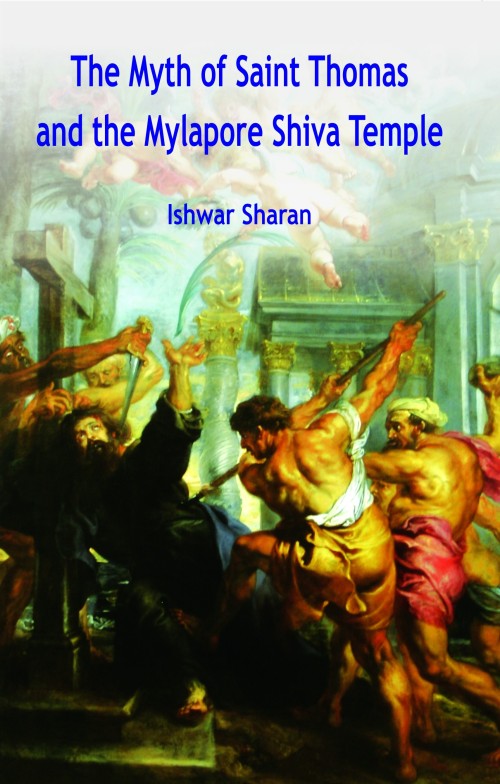
The Fourth Revised Edition of The Myth of Saint Thomas and the Mylapore Shiva Temple is available in print from Voice of India and Amazon › Pages 451 › Price Rs 395 › ISBN 978-9385485-20-6.
The 2019 edition of The Myth of Saint Thomas and the Mylapore Shiva Temple is a complete study of the St. Thomas in India legend—its origin, history in India, and communal ramifications. The book is named after the main, 24-chapter essay by Ishwar Sharan and includes authoritative, independent articles by senior journalists and research scholars.
The book exposes the vicious blood libel perpetrated by Christians against Hindus for centuries, that a Hindu king and his Brahmin priests murdered Apostle Thomas on a hilltop in south Madras, and the unconscionable support for this libel by India’s mainstream secular media.
Notably a chapter in the book documents the pronounced pro-Christian bias of the Encyclopaedia Britannica and popular on-line reference portal Wikipedia. Both encyclopedias carry fanciful, non-factual entries for St. Thomas the Apostle in India that they refuse to correct or change.
And last but not least, the book documents the destruction of the original Kapaleeswara Shiva Temple by the Portuguese and its replacement by San Thome Cathedral on the Mylapore seashore in Chennai.
The book has an extensive bibliography and is a valuable tool for researchers and historians.

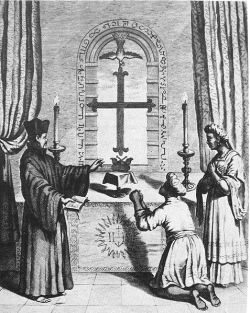
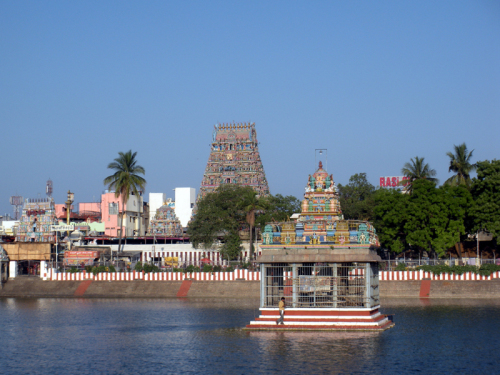
Sri Kapaleeswara SHIVA Temple: This is the second temple built in the 17th century by Mayil Nattu Muthiyappa Mudaliar after the Portuguese destroyed the original temple on the Mylapore seashore and replaced it with the first St. Thomas Church.
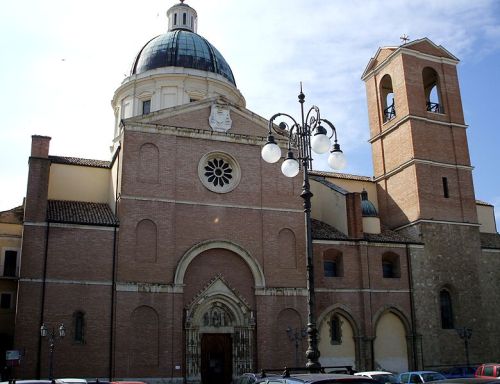
San Tommaso Cathedral Basilica, Ortona, Italy: This cathedral in the diocese of Lanciano-Ortona, has held the complete skeletal remains of St. Thomas since 1258.
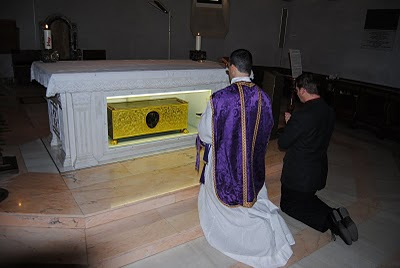
The tomb containing the relics of St. Thomas in San Tommaso Basilica, Ortona, Italy.
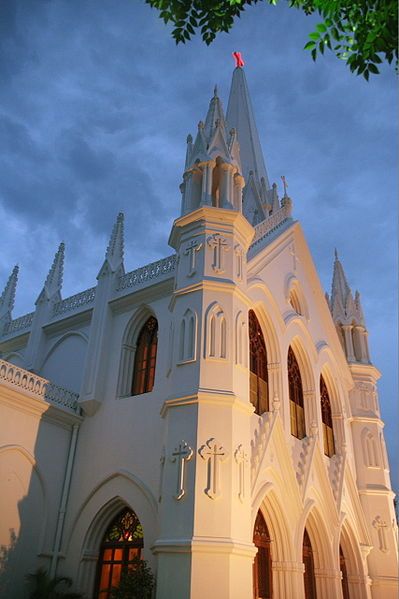
San Thome Cathedral, Mylapore, Chennai (Madras), India.
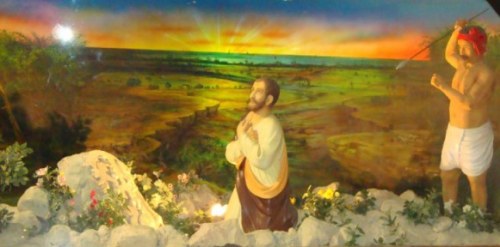
Blood Libel: This diorama of St. Thomas and his alleged Hindu assassin was built in the San Thome Cathedral crypt after the publication of Ishwar Sharan’s book exposing the myth in 1995. Its objective is to malign the Hindu community with the accusation of the murder of St. Thomas on a hilltop in south Chennai (Madras).

The fake tomb of St. Thomas in San Thome Cathedral Basilica, Mylapore, Chennai.
________________________________________________________________________________________________________________________________________________________________________________
Recommended Read :
Author : TRUE INDOLOGY and NS RAJARAM
According to Christian leaders in India, the Apostle Thomas came to BHARAT in 52 ad., founded the Syrian Christian Church, and was killed by the fanatical Brahmins in 72 ad. His followers built the St. Thomas Church near the site of his martyrdom. Historians however say this apostle, even if he existed, never came to India. The Christian community in South India was founded by a Syrian (or Armenian) merchant Thomas Cananeus in 345 ad. He led four hundred refugees who fled persecution in Persia and were given asylum by the Hindu authorities.
This story was too commonplace to attract converts. So Christian leaders identified the merchant Thomas with Apostle Thomas and created the dramatic story of the Apostle’s persecution and death at the hands of the “wicked”Brahmins of South India. This became current in the 16th century when thePortuguese gained control of the west coast of India and forced the Syrian Christians to follow the Catholic faith. The Portuguese also destroyed theKapaleeswara Temple that originally stood on the site now occupied by the San Thome Cathedral on the beach.
The creation of this myth and the history is told in detail by the well renowed scholar Ishwar Sharan in his famous book The Myth of St. Thomas and the Mylapore Shiva Temple. The purpose of the myth was to create a local martyr. Christianity depends heavily on the appeal of martyrs who are projected as victims like Jesus Christ. Then as now, Church leaders liked to pose as victims to generate sympathy and propaganda. But no matter how much they tried, the Hindus of India refused to supply the Portuguese with martyrs. So they were forced to create their own. So they turned the merchant Thomas into the Apostle Thomas killed by the Hindus.
In his foreword to Ishwar Sharan’s book, the Belgian scholar Koenraad Elst wrote:
“In Catholic universities in Europe, the myth of the apostle Thomas going to India is no longer taught as history, but in India it is still considered useful. Even many vocal ‘secularists’ who attack the Hindus for relying on myth in the Ayodhya affair, off-hand profess their belief in the Thomas myth. The important point is that Thomas can be upheld as a martyr and the Brahmins decried as fanatics.”
The legend of Thomas’ Martyrdom in the hands of Brahmins has its origin an ignorant and intentional misreading of an inscription.
Targeting Brahmins to undermine Hinduism was a favorite tactic among missionaries. Elst gives the true picture: “In reality, the missionaries were very disgruntled that the damned Hindus refused to give them martyrs (whose blood is welcomed as ‘the seed of the faith’), so they had to invent one. Moreover, the church which they claim commemorates St. Thomas’ martyrdom at the hands of Hindu fanaticism, is in fact a monument of Hindu martyrdom at the hands of Christian fanaticism. It is a forcible replacement of two important Hindu temples (Jain and Shaiva) whose existence was insupportable to the Christian missionaries.”
Another motivation for the myth was to erase the unsavory record of the Catholic Church’s close association with the Portuguese pirates and even worse, the Goa Inquisition inspired by St. Xavier. But serious scholars including Christians have rejected this myth as we shall soon see.
Who was this Apostle Thomas and why was his name invoked? The main sources relating to Apostle Thomas are two Gnostic (non-Biblical) texts known as the Acts of Thomas and the Gospel of Thomas. According to them Thomas was the twin brother of Jesus. For this reason the Thomas myth is not accepted by the Vatican because of a doctrinal problem: Jesus as the Only Son of God cannot possibly have a twin brother. (Greek for Thomas is Didymus, which means twin brother.)
Christians in South India who identify themselves as St. Thomas Christians claim that their ancestors were blessed by Apostle Thomas in 52 ad. who preached from the Bible. This has no historical basis as we shall see. In fact, there is no evidence that Thomas even existed. His “history” is full of contradictions as will become apparent.
As just observed the Portuguese missionaries who came to India in the 16th century found that they could not do without a local martyr and created the myth of St. Thomas claiming that he was martyred in India. They gave no explanation as to how they discovered it more than 1500 years later. Marco Polo is supposed to have mentioned it but there is no authenticmanuscript that can be attributed to him. Then there is the question of how he discovered it more than a thousand years later.
There is even a tomb that is supposed to contain his martyred remains in Mylaporein Chennai. But the problem is there are several such memorials spread across Persia, Acre (Israel) and a few other places dating to different times, all laying claim to be the place where Apostle Thomas was martyred and buried!
After examining all the evidence, the late Father Heras, former Director of the Historical Research Institute, St. Xavier’s College, Bombay, said in 1953 that he was convinced that the tomb of St. Thomas was not in Mylapore. He had earlier said, quite emphatically in The Aravidu Dynasty of Vijayanagara, that the Portuguese account of their discovery of some relics was “a most barefaced imposture [with] all elements of a forgery.” Heras was himself a Jesuit father but also an eminent historian.
This is not the end of the story, for while denying the myth because it challenges Jesus as the “Only Son of God” the Vatican wants to have it both ways. On September 27, 2006, Pope Benedict XVI gave a speechat St. Peter’s in Rome in which he recalled an ancient tradition claiming that Thomas first evangelized Syria and Persia, then went on to Western India, from where Christianity also reached Southern India. Syrian Christians derive status within the caste system from the tradition that they are converted Namboothiris (Brahmins), who were allegedly evangelized by St. Thomas after his delusional landing in Kerala in ad 52.
There are serious problems with this theory: the Namboothiris started settling in Kerala only from the fourth century onwards, which means they did not exist at the time the alleged St. Thomas allegedly came to Kerala. So we have a possibly non-existent apostle preaching in the first century from a text, the New Testament, dating to the fourth century, to a people, the Namboothiris who settled in the fourth century or later. In reality the Pope’s original statement at St. Peter’s, reflected the geography of the Acts of Thomas, i.e. Syria, Parthia (Persia / Iran) and Gandhara (Afghanistan / Northwest Pakistan) — all far removed from Kerala in the southernmost tip of India.
This is not the end to the contradictions. If Thomas landed in Kerala in 52 AD, he could not have taught from the Christian Bible(New Testament) with its four gospels which came into existence only in the fourth century. In fact Christianity did not exist at the time because there was no Christian scripture! In addition, the famous St. Thomas Cross supposedly brought by him made its appearance in Kerala only in the fourth century, about the same time as the Namboothiri Brahmins. So it is quite possible that the highly ornate St. Thomas Cross [with Hindu motifs carved in it] was borrowed from the Namboothiris, having nothing to do with St. Thomas or even Christians. The Church borrowed its cross from the Egyptians and the oldest so-called St. Thomas Cross is a pagan Persian symbol.
As if this were not confusing enough, FatherFrancis Clooney, a theologian with the harvard School has stated that St Thomas had preached in Brazil, no matter that Brazil as we understand today was unknown in his time. According to Clooney, one Ruiz de Montoya, writing in Peru in the mid-seventeenth century, thought that since God would not have overlooked the Americas for fifteen hundred years, and since among the twelve apostles St. Thomas was known for his mission to the “most abject people in the world, blacks and Indians,” it was only reasonable to conclude that St. Thomas had preached throughout the Americas:
“He began in Brazil – either reaching it by natural means on Roman ships, which some maintain were in communication with America from the coast of Africa, or else, as may be thought closer to the truth, being transported there by God miraculously. He passed to Paraguay and from there to the Peruvians.
So here is the substance of the St. Thomas story. First, if he existed he was a twin brother of Jesus which is unacceptable because Jesus was the Only Son of God(born to a virgin). Next, he could not have preached Christianity in 52 AD because Christianity and the New Testament came into existence only in the fourth century, after the Council of Nicaea called by Roman Emperor Constantine in 325 AD. The first Christians came to India with the Syrian merchant Thomas in 345 AD escaping persecution in Persia. This was probably because Roman and Persian empires were great rivals. The Namboothiri Brahmins settled in Kerala only after the fourth AD, so could not have been converted by Apostle Thomas in 52 AD using the Bible from three centuries later.
Finally, the myth was created by Portuguese missionaries in the sixteenth century with the help of pirates. They destroyed also the Kapaleeswara Temple and a Jain temple building the church known as San Thome Cathedral in 1504. It acquired its present status and recognition as a cathedral (grand church) under British patronage in 1893. It was also the Portuguese who converted the Syrian Christians to the Catholic faith.
Hence there is absolutely no need to take this hoax of st. thomas seriously. Its all fabrication stories.
In an article recently published by Haaretz, it has been claimed that Saint Thomas was murdered by jealous Brahmin priests of Kali with the headline– 72 CE: Thomas the Apostle Is Murdered in India. The official website of Saint Thomas(Santhome) church states-
St Thomas, one of the twelve Apostles of our Lord and Saviour Jesus Christ, walked on the sands of Mylapore and preached the Gospel to the people who embraced Christianity. This great Apostle was martyred on St Thomas Mount, near Mylapore in the year 72 AD and his mortal remains were buried in Santhome in the Church built by him….
The claims are summarised as follows
- Saint Thomas, one of the twelve apostles of Christ, came to India in 52 AD.
- He preached gospel and converted a lot of people.
- The jealous Hindu Brahmin priests killed him by piercing him with spears.
- His relics are still enshrined in Santhome church in Mylapore, Madras.
The Portuguese Crusade.
As soon as they reached Calicut in 1498, the Portuguese announced that they were looking for spices and “Christians” . In Kerala, the Portuguese encountered Christians who were mostly known as “Syrians” and “Thomas Christians”. The search for “Christians” was obviously a justification and legitimization of future conquests. The Portuguese could simply portray their future conquests as a crusade to reconquer lost Christian lands. The Portuguese also claimed that conquest of non-Christian lands was an accomplishment that could closely precedent last Judgement. Portuguese historian Ameal sums up the Portuguese age of expansion as follows-
Wherever the Portuguese fleet cast anchor in the past, barbarity disappeared while the idols of tyranny, hatred, and gold were replaced by the cross of Christ. No colonization was more beautiful and noble….
Thus, it is clear that Portuguese conquest/expansion and Christianization went hand in hand.
India and christianity.
The tales of “Thomas in India” were well known throughout Europe in the medieval age. Hagiographical Latin works on Saint Thomas such as Flos sanctorum, De miraculis beati Thomae apostoli and Passio Sancti Thomae were well known in literary circles. These Latin works were not a faithful translation of the original Christian apocryphal scripture, Acts of Thomas, but further reworkings of it.
Given this background, it is no surprise that as early as 1507, the Portuguese Viceroy Almeida sent out a preliminary expedition to south to look for the tomb of St Thomas the Apostle . As observed, any discovery of St. Thomas would legitimise their conquests. However, the first mission was a total failure and Portuguese failed to find what they were looking for.
Thomas Legends procured from native “Thomas” Christians.
As a part of this grand project, Portuguese writer Duarte Barbosa completed his work “Geographical compendium of Portuguese Asia”(c.1518). He provided his account of the life and death of St. Thomas in India by reproducing the oral stories of the St. Thomas Christians from the region of Kollam(Kerala).
This account of St. Thomas in India, based on the oral stories, was full of myths. Relevant to us, however, is a striking reference on the “martyrdom” of saint Thomas. The miracle worker Thomas transformed himself into a peacock and wandered around. A low caste govi hunter shot at it. The hunter was shocked when the peacock retransformed itself into its original form of Saint Thomas.
Thus,in the earliest legends of Thomas Christians, St. Thomas was killed not by jealous Brahmins but by a low caste hunter who mistook him for a peacock. The legend of transformation of Thomas into peacock prior to his accidental death at the hands of a hunter was also noted centuries earlier by Marco Polo(1296) who collected his legends from the accounts of local Christians.
We pause and ask, why did Barbosa rely on the local accounts of St. Thomas Christians to reconstruct the history and martyrdom of St. Thomas? The Acts of Thomas which talked about martyrdom of Thomas in “India” was an old Apocryphal Biblical text. As noted, the Europeans had their own medieval accounts of Thomas’ martyrdom.
The Portuguese considered St. Thomas Christians as “heretics” and “Nestorians” and would soon force the Catholic religion upon them. Why did the Portuguese adopt late mythical foreign accounts of Hinduised “heretics” and discard their own versions of Thomas legend?
The answer lies in the fact that the Apocryphal text Acts of Thomas(written 3rd century) was never received very well in Christendom. As early as 310 AD, foremost early Christian historian and bishop Eusebius classified apocryphal acts as “heretical works” written by the “wicked and impious”.
Epiphanus of Salamis( 370AD) testified that Acts of Thomas were used by the “heretic Encratites”. After protestant reformations, the Catholics began a counter reformation movement and embraced stricter orthodoxy. The Acts would soon be condemned in the Catholic Council of Trent(1548 AD). Although not translations, the medieval works on saints were still based on Acts. Hence, even these works were considered “unorthodox”.
There is also another reason for discarding the western legends. According to the Acts of Thomas, the body of St. Thomas was taken to the West after his death.Ephraim the Syrian(d.377) mentioned that the body of Thomas was venerated in Edessa(Syria) .
Gregory of Tours (583-594) evoked the Syrian tradition in shifting St.Thomas’s burial from India to Edessa. By 1258,it was taken to Ortona, Italy where the skeleton of St. Thomas is venerated to this day. The Vatican also acknowledged these relics of “Thomas” with “deed of verification” meaning that the Christendom considers it to be the ‘real skeleton’ of St. Thomas.
Even in the widely read Travels of Sir John Mandeville(c.1499), it was stated that Thomas’ body was taken to Edessa(Syria, now Turkey) from India after his death. Had Portuguese adopted the old western legends of Thomas, they could not have claimed any Thomas grave in India. But as we have noted before, this was crucial for legitimization of their conquests.
Geographical expansion of the site.
In 1517, Armenian merchants came to the rescue of the Portuguese. They talked about a sepulchre of St. Thomas and persuaded a group of Portuguese returning from Melakka to travel to a site in Mylapore reputed to be St. Thomas’ tomb. When they arrived, what they found were partially ruined temples. Below we quote description of what the Portuguese saw when they arrived at supposed tomb of St. Thomas in Mylapore-
They found a vast expanse covered with buildings, for most part in ruins. Amongst these ancient remains were gopuras, towers, columns, stones covered with sculptures representing foliage, human figures, animals, birds of such exquisite workmanship that they could not have been finer even wrought in silver …
They found that the tomb was visited by heathens(Hindus) and Moors(Muslims), in addition to local Christians. Even Marco Polo had written centuries earlier that the tomb used to be visited by “Saracens(Muslims) and Christians.”
The tomb itself was managed by a Muslim who claimed it to be a tomb of a Muslim saint from Ethiopia. However, the presence of temples at the place of St. Thomas’ martyrdom should not have come as a surprise to Portuguese. Consider a more than century older testimony of Christian monk Odoric of Udine who recalled a visit he had made to this Tomb in 1322.
His church is filled with idols and beside it are fifteen houses of the Nestorians, that is to say Christians, but vile and pestilential heretics…
These Jesuit historians claim that this had been a temple of a Jogi which was appropriated by Thomas himself. But they are only partially correct. It was indeed a temple of a Jogi, but it is the Portuguese, not Thomas, who have appropriated it.They also found footprints which they considered to be those of St. Thomas. However, veneration of footprints is a Hindu-Jain-Buddhist practice.
We have further testimony from Manual Gomes, a Portuguese who took part in the expedition. They saw another tomb, which, they were sure, was that of St. Matthew the apostle and alleged author of canonical gospel.
The Portuguese then began reconstruction of this site, now called “St. Thomas chapel”. The tombs were opened one after the other and their bones exhumed. The Tamil inscription of what had until now been considered “St. Matthew’s Tomb” read as “tane mudaliar” and was found to be that of a Chola ruler. The Portuguese took a massive U turn.
Now, St. Matthew’s tomb became that of Chola ruler who had been a “disciple” of St. Thomas. It did not matter to them that the Chola ruler and St Thomas were separated by a time frame of 12 centuries. The tomb of “St. Thomas” was also exhumed. Among the finds was a wooden shaft of St. Thomas which miraculously survived for 15 centuries.
The Portuguese began their project and built churches all over the place. Retired Portuguese traders and Jesuit priests began to settle in Mylapore. A large number of locals were converted and a Christian colony in Mylapore was now a fact.
Brahminic(Jesuit?) reconstruction of Thomas’ Myth.
The tomb of St. Thomas was located on Little Mount(chinna malai) of Mylapore. The Portuguese also constructed a chapel on Big Mount(Periya Malai) to the south east of tomb. One day, during an excavation on the Big Mount, the Portuguese claimed to have come across an exciting find. They suddenly found a cross with small “drops of blood” on its surface. They also found an inscription on it. They invited a learned Brahmin named Pingali Suranna to decipher the inscription. Suranna translated it much to the delight of Portuguese which read as follows-
During the time of the Sagamo laws, Thomas the divine man was sent by the Son of God (whose disciple he was) to these countries to lead the people of this nation to the knowledge of God, and he erected a temple and performed miracles and finally, while he was praying on his knees before this cross, he was pierced by a Brahman’s spear and this cross was tinged with his blood for eternal memory…..
It should be mentioned that this version of Thomas’ Martyrdom corresponds to the version Jesuit priests knew from their books such as Acts of Thomas. There is however an important difference. In the Acts of Thomas, Thomas was killed by the king because he converted the queen and instructed her not to have any sexual intercourse with the king. It seems Jesuits wanted to implicate Brahmins and localise the myth. It is interesting that Suranna words come across as though from a Jesuit’s mouth.
Now, the Thomas legend underwent major reconstructions. It wasn’t a peacock hunter who accidentally killed Thomas but a Brahmin who intentionally committed the deed. The Little mount(cinna malai) was no longer the resting place of Thomas. Thomas was pierced by a spear on the Little mount after which he fled to the Big Mount, finally dying there, clasping the cross. The Big Mount was now the final resting place of Thomas, as it is until today.
One wonders how the Brahmin Suranna was able to read the indecipherable inscription. Brahmins were trained in Vedas and traditional sciences such as mathematics(Ganita), astrology and Ayurveda, but not linguistic epigraphy. The Brahmins with all their knowledge had no idea what Brahmi script was.
Thanks to James Princep the epigraphist who deciphered Brahmi in 1837, we are in a much better position to understand Indian history. Now we now know what was inscribed on the cross, thanks to modern day Epigraphists. The inscription is in Pahlavi. It is dated to circa. 8th century CE. It read-
My Lord Christ, have pity on Afras, son of Chaharbukt the Syrian, who has carved this….
As we see, there is no mention of any St. Thomas, let alone his Martydom. Thus, the legend of Thomas’ Martyrdom in the hands of Brahmins has its origin an ignorant and intentional misreading of an inscription.
It is most likely, that the inscription was brought from Goa and deliberately planted it on the mount.Recently,a similar inscription was found at Goa.
Indologist Dr. Koenraad Elst has written a comprehensive foreword for the book. His short foreword to the 1995 edition is posted below as he makes some pertinent remarks about Indian secularists and their uncritical acceptance of Christian mythology as Indian history.
Dr. KOENRAAD ELST studied under Jesuits at Katholieke Universiteit in Belgium, Europe’s oldest Catholic university at Leuven, and is in a position to say with authority that the St. Thomas in India tale today is a fraud on the people of India by crafty, untruthful Catholic priests who make their living by fooling the faithful. He writes:
The Myth of Saint Thomas and the Mylapore Shiva Temple – 2019 – Ishwar Sharan.According to Christian leaders in India, the apostle Thomas came to India in 52 AD, founded the Syrian Christian Church, and was killed by the fanatical Brahmins in 72 AD. Near the site of his martyrdom, the St. Thomas Church was built. In fact this apostle never came to India. The Christian community in South India was founded by a merchant called Knai Thoma or Thomas of Cana in 345 AD—a name which readily explains the Thomas legend. He led four hundred refugees who fled persecution in Persia and were given asylum by the Hindu authorities.
In Catholic universities in Europe, the myth of the apostle Thomas going to India is no longer taught as history, but in India it is still considered useful. Even many vocal “secularists” who attack the Hindus for “relying on myth” in the Ayodhya affair, off-hand profess their belief in the Thomas myth. The important point is that Thomas can be upheld as a martyr and the Brahmins decried as fanatics.
In reality, the missionaries were very disgruntled that the damned Hindus refused to give them martyrs (whose blood is welcomed as “the seed of the faith”), so they had to invent one. Moreover, the church which they claim commemorates St. Thomas’s martyrdom at the hands of Hindu fanaticism, is in fact a monument of Hindu martyrdom at the hands of Christian fanaticism. It is a forcible replacement of two important Hindu temples—Jain and Shaiva—whose existence was insupportable to the Christian missionaries.
No one knows how many Hindu priests and worshipers were killed when the Christian soldiers came to remove the curse of Paganism from the Mylapore beach. Hinduism does not practice martyr-mongering, but if at all we have to speak of martyrs in this context, the title goes to these Jina- and Shiva-worshipers and not to the apostle Thomas.

The Fourth Revised Edition of The Myth of Saint Thomas and the Mylapore Shiva Temple is available in print from Voice of India and Amazon › Pages 451 › Price Rs 395 › ISBN 978-9385485-20-6.
The 2019 edition of The Myth of Saint Thomas and the Mylapore Shiva Temple is a complete study of the St. Thomas in India legend—its origin, history in India, and communal ramifications. The book is named after the main, 24-chapter essay by Ishwar Sharan and includes authoritative, independent articles by senior journalists and research scholars.
The book exposes the vicious blood libel perpetrated by Christians against Hindus for centuries, that a Hindu king and his Brahmin priests murdered Apostle Thomas on a hilltop in south Madras, and the unconscionable support for this libel by India’s mainstream secular media.
Notably a chapter in the book documents the pronounced pro-Christian bias of the Encyclopaedia Britannica and popular on-line reference portal Wikipedia. Both encyclopedias carry fanciful, non-factual entries for St. Thomas the Apostle in India that they refuse to correct or change.
And last but not least, the book documents the destruction of the original Kapaleeswara Shiva Temple by the Portuguese and its replacement by San Thome Cathedral on the Mylapore seashore in Chennai.
The book has an extensive bibliography and is a valuable tool for researchers and historians.



Sri Kapaleeswara SHIVA Temple: This is the second temple built in the 17th century by Mayil Nattu Muthiyappa Mudaliar after the Portuguese destroyed the original temple on the Mylapore seashore and replaced it with the first St. Thomas Church.

San Tommaso Cathedral Basilica, Ortona, Italy: This cathedral in the diocese of Lanciano-Ortona, has held the complete skeletal remains of St. Thomas since 1258.

The tomb containing the relics of St. Thomas in San Tommaso Basilica, Ortona, Italy.

San Thome Cathedral, Mylapore, Chennai (Madras), India.

Blood Libel: This diorama of St. Thomas and his alleged Hindu assassin was built in the San Thome Cathedral crypt after the publication of Ishwar Sharan’s book exposing the myth in 1995. Its objective is to malign the Hindu community with the accusation of the murder of St. Thomas on a hilltop in south Chennai (Madras).

The fake tomb of St. Thomas in San Thome Cathedral Basilica, Mylapore, Chennai.
________________________________________________________________________________________________________________________________________________________________________________
Recommended Read :
Last edited:





